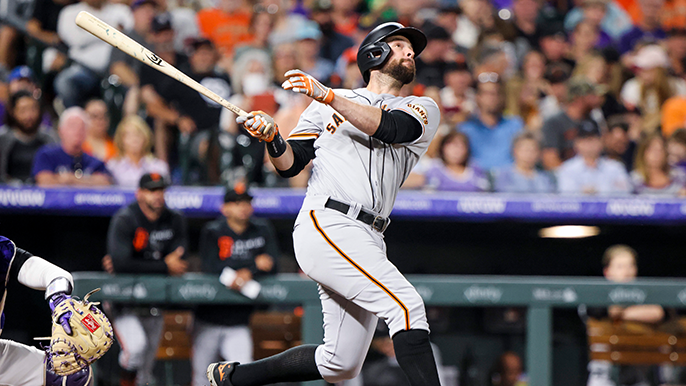
During Sunday’s collective bargaining agreement negotiation session, the MLB Players Association reportedly offered the league the ability to make on-field rule changes as early as 2023.
The rules in question include banning infield shifts, which have become increasingly popular during the analytics revolution. The shift has always existed, but the league average has boomed from 13.7% with no runners on base in 2016 to 30.9% last year, per Baseball Savant.
Although implementation of a shift ban likely won’t be implemented this season — whenever and in whatever form that may be — any change to gameplay is worth examining (we looked at how the Giants might approach the universal designated hitter in February).
As the lockout persists, looking forward to the potential rule change and how it could eventually impact the Giants is a worthwhile exercise. It is real baseball, after all.
What’s the shift, and what’s the big deal?
The most common shifting tactic clubs have executed is placing an infielder in shallow right field and moving the third baseman over to shortstop. The strategy in general is significantly more common against left-handed hitters with the goal of taking away singles through the hole between first and second base.
No team shifted more in 2021 than the Los Angeles Dodgers, who contorted their infielders on 53.6% of plate appearances with no runners on base, per Baseball Savant. LAD was much more aggressive than typical teams against righties, shifting 42% of their plate appearances. Houston led baseball in shifts against left-handed batters at 81.5%. Philadelphia, meanwhile, shifted the least frequently — 17.2% — under old school manager Joe Girardi.
Royals Designated hitter Carlos Santana saw the most shifts among any regular player in 2021, facing a shift in 97.6% of plate appearances.
Proponents of the shift argue hitters should simply adjust. With just one fielder to the left of second base, lefties have an opportunity to lay down bunts or slap the ball to the opposite field.
But the effect of shifts has led to more of a “three true outcomes” result. Hitters have more often tried to hit over the shift, increasing launch angle which produces more home runs and strikeouts. The goal of banning infield shifts would be to incentive more balls in play, and therefore more action.
It’s not clear what the specifics of the rule change would be, but in Double-A, all four infielders are required to have their cleats in the dirt when a pitch is delivered.
Where the Giants fit in on defense
Gabe Kapler and the Giants are one of the more analytics-friendly clubs, but shifted in the bottom-third of teams in 2021. That may be due to having strong defensive infielders like Brandon Crawford and Brandon Belt.
Against right-handed hitters, the Giants shifted 5.8% of the time, tied for second-fewest in the league. Even against left-handed hitters, the Giants were still middle of the pack, shifting 50.4% of the time — 18th in MLB.
The conservative approach to shifting didn’t hurt the 107-win Giants, who finished with 32 defensive runs saved, per Fangraphs. That number had them tied for 10th in MLB.
So with the shift ban in place, the Giants won’t have to overhaul their defensive strategy. The rule change also would place a premium on plus defenders, like Crawford and Belt — an advantage for San Francisco.
How the shift ban could impact the Giants at the plate
Brandon Belt saw the most shifts of any Giants hitter. He fared just fine, slashing .274/.378/.597 with a career-high 29 home runs.
Defenses shifted against the pull-hitting first baseman 86.5% of the time — 22nd most in MLB. Seeing fewer shifts will make Belt even more dangerous; in the 13.5% of plate appearances against traditional infields, Belt’s weighted on-base percentage (wOBA) shot up from .396 to .477.
Outfielder Mike Yastrzemski also saw a significant amount of defenses shifting to him, with 72.9% of his plate appearances without runners on base coming against a loaded infield. Yastrzemski recorded a .309 wOBA in those situations. The strategy makes sense, as Yaz pulled over a third of balls he put into play.
Yastrzemski’s struggles in the batter’s box in 2021 likely have more to do with off-speed pitch recognition and a mental battle that stemmed from getting hit by a Sean Manaea pitch in spring training. Still, he’d certainly benefit from a shift ban.
Tommy La Stella and LaMonte Wade Jr. were the only other Giants in the top-100 of rate of shifts faced among players with at least 100 plate appearances.
In general, the shift ban will make power-hitting left-handed hitters more valuable. Knowing it’s coming, the Giants could more aggressively pursue hitters like Kyle Schwarber or Freddie Freeman in free agency once the lockout is lifted. San Francisco still has a need for a right-handed hitter, given Kris Bryant’s likely departure and Buster Posey’s retirement, but it could be an opportune time to splurge on a long-term left-handed hitting option.


